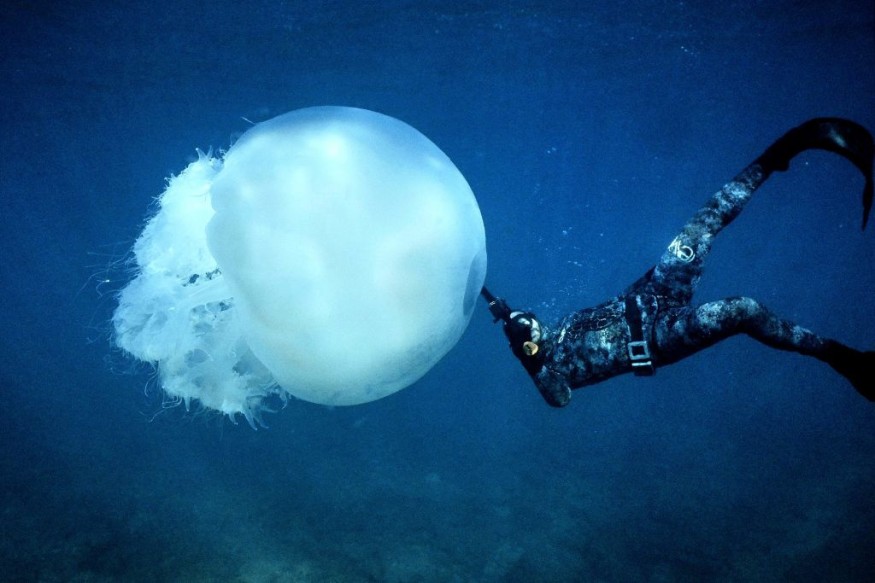From shapeshifting fishes to glass-like jellies, the weirdest, most bizarre deep-sea creatures made the year 2021 no different than any other year, as strange new species makes themselves known to the world. Every year, researchers were able to capture video footage of these "alien-looking animals".
Here is the top 10 list of weird creatures found in the deep sea in 2021 made by LiveScience:
2021 Deep Sea Expedition Sightings

10. Blood-red jellyfish
The National Oceanic and Atmospheric Administration (NOAA) discovered a new species of red jellyfish during its 2021 North Atlantic Stepping Stones expedition, The Hill reported. According to researchers, the brand-new and unnamed species likely belongs to the genus Poralia. Found off the coast of New Jersey at a depth of 2,297 feet, the red jellyfish has peculiar number of tentacles and warts on the bell, which made it capable of stinging.
Many deep sea creatures may appear black because red wavelengths of light do not penetrate into the deep ocean.
9. Elusive glass octopus
Off the coast of the remote Phoenix Islands, a team of researchers from the Schmidt Ocean Institute (SOI) released footage of an elusive glass octopus (Vitreledonella richardi) originally discovered during a 34-day expedition of the Central Pacific Ocean onboard the SOI's research vessel, Falkor. The glass-like cephalopod was "almost completely transparent" with only cylindrical eye, optic nerve and digestive tract showing.
8. Shape-shifting whalefish
Meanwhile, around 6,600 feet (2,013 m) deep offshore of Monterey Bay, California, a bright orange, female whalefish of the order Cetomimiformes was discovered by Monterey Bay Aquarium Research Institute (MBARI) researchers. What made the fish so bizarre was that researchers observed that they had three different appearances - one for the juveniles (tapetails), one for males (bignoses) and another for females (whalefish).
It was believed that their shape-shifting transformation from juvenile to mature females is "one of the most extreme among any vertebrates."
7. 'Emperor Dumbo'
'Emperor Dumbo', a brand-new species of Dumbo octopus (Grimpteuthis imperator) was first discovered in 2016 when it was accidentally caught in a net and dragged into the surface by a German research vessel.
"It was a really lucky find,"Alexander Ziegler, a researcher at Friedrich Wilhelm University in Bonn, Germany, and chief scientist onboard the research vessel, told Live Science, "because we weren't really looking for it. Plus, the whole animal came to the surface intact."
6. Real-life SpongeBob and Patrick
The real-life counterparts of the cartoon characters SpongeBob Squarepants and Patrick Star were captured by NOAA side-by-side on the seafloor, from genus Hertwigia and Chondraster, respectively. The two garnered numerous interactions on Twitter when marine biologist Christopher Mah first made the comparison on the social media site.
5. Alien-like spindly squid
The rare 'ghostly' bigfin squid (of the genus Magnapinna) discovered during an expedition in the Gulf of Mexico have this "long, spaghetti-like" hands or tentacles, which is difficult to tell. The deep-sea cephalopod was first discovered in 1998 and had only been sighted a few times, fewer than 20.
4. Giant phantom jellyfish
A massive jelly with 1m bell and 10m ribbon-like arms was spotted at a depth of 3,200 feet (975 m) in Monterey Bay, California. The giant phantom jellyfish (Stygiomedusa gigantea) has arms which looks like loose scarves, propelling itself through the pitch-black depths and faintly glowing bell.
The species has been rarely spotted by scientists, about 100 times since 1899.
3. Photobombing squid
While researchers from OceanX were filming the remains of a shipwreck from 2011, their ROV was continuously photobombed by a purpleback flying squid (Sthenoteuthis oualaniensis). At a depth of around 2,788 feet (850 m), scientists think it was a solitary squid, but there may have been others if only the cephalopod was identified as it zoomed across the screen.
2. Sponge tracks on the seafloor
The first evidence of deep-sea sponges was captured crawling around on the seafloor, left behind by mobile creatures in the Arctic. It was first photographed in 2016 by towed cameras behind a research vessel at Langseth Ridge, but was poorly studied in the region of the Arctic Ocean since it had gotten permanently covered in sea ice.
1. See-through skull
A rare glimpse of a barreleye fish (Macropinna microstoma) with translucent forehead was caught by MBARI researchers. The strange fish seems to use a pair of bulbous green eyes inside its head. It was filmed at a depth of about 2,132 feet (650 m) in the Monterey Submarine Canyon, one of the deepest submarine canyons on the Pacific coast.
According to a senior aquarist, the creature first appeared very small out in the blue distance, but "couldn't have been mistaken for anything else."
Life at the Farthest Depths of the Ocean
The environment down the ocean floor is not as hospitable as it is on the surface, with conditions that exceed anything human bodies can handle. It was once thought that no life could possibly survive in the dark, cold, pressurized depths of the ocean, but several underwater explorations say otherwise. Using underwater vehicles, researchers were able to reveal an amazing world full of bizarre life forms that you didn't know even existed, like creatures straight out from fiction books.
Even in the most remote and inhospitable corners of the planet, there could be a whole community adaptation that life has made to survive.
Related article : Experts Struggle to Identify Bloated Alien-Like Creature Washed Up on Australian Beach
© 2025 NatureWorldNews.com All rights reserved. Do not reproduce without permission.





